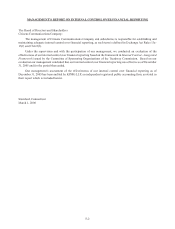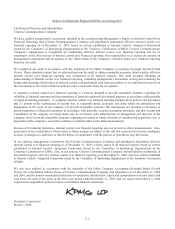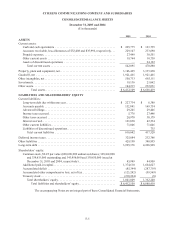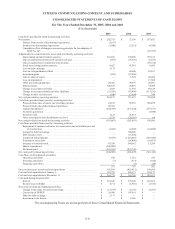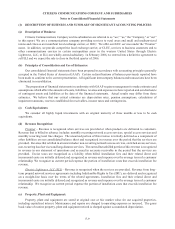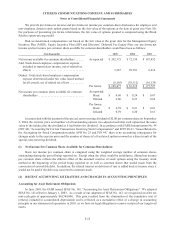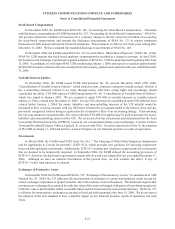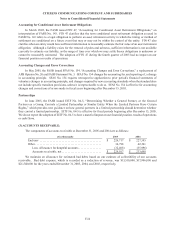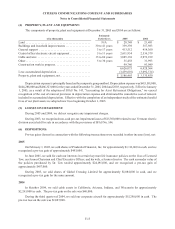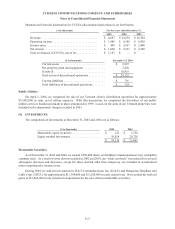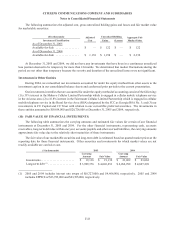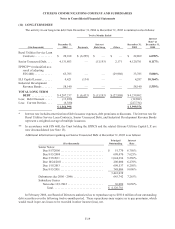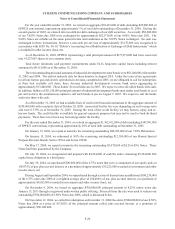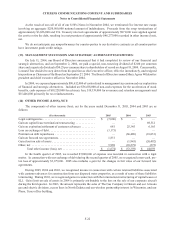Frontier Communications 2005 Annual Report Download - page 61
Download and view the complete annual report
Please find page 61 of the 2005 Frontier Communications annual report below. You can navigate through the pages in the report by either clicking on the pages listed below, or by using the keyword search tool below to find specific information within the annual report.
F-12
CITIZENS COMMUNICATIONS COMPANY AND SUBSIDIARIES
Notes to Consolidated Financial Statements
We provide pro forma net income and pro forma net income per common share disclosures for employee and
non-employee director stock option grants based on the fair value of the options at the date of grant (see Note 18).
For purposes of presenting pro forma information, the fair value of options granted is computed using the Black
Scholes option-pricing model.
Had we determined compensation cost based on the fair value at the grant date for the Management Equity
Incentive Plan (MEIP), Equity Incentive Plan (EIP) and Directors’ Deferred Fee Equity Plan, our pro forma net
income and net income per common share available for common shareholders would have been as follows:
($ in thousands) 2005 2004 2003
Net income available for common shareholders . . . . . . As reported $ 202,375 $ 72,150 $ 187,852
Add: Stock-based employee compensation expense
included in reported net income, net of related tax
effects . . . . . . . . . . . . . . . . . . . . . . . . . . . . . . . . . . . . 5,267 29,381 6,014
Deduct: Total stock-based employee compensation
expense determined under fair value based method
for all awards, net of related tax effects . . . . . . . . . . (8,165) (38,312) (16,139)
Pro forma $ 199,477 $ 63,219 $ 177,727
Net income per common share available for common
shareholders . . . . . . . . . . . . . . . . . . . . . . . . . . . . . . .
As reported:
Basic $ 0.60 $ 0.24 $ 0.67
Diluted 0.60 0.23 0.64
Pro forma:
Basic $ 0.59 $ 0.21 $ 0.63
Diluted 0.59 0.20 0.61
In connection with the payment of the special, non-recurring dividend of $2.00 per common share on September
2, 2004, the exercise price and number of all outstanding options was adjusted such that each option had the same
value to the holder after the dividend as it had before the dividend. In accordance with FASB Interpretation No. 44
(FIN 44), “Accounting for Certain Transactions Involving Stock Compensation” and EITF 00-23, “Issues Related to
the Accounting for Stock Compensation under APB No. 25 and FIN 44,” there is no accounting consequence for
changes made to the exercise price and the number of shares of a fixed stock option or award as a direct result of the
special, non-recurring dividend.
(l) Net Income Per Common Share Available for Common Shareholders:
Basic net income per common share is computed using the weighted average number of common shares
outstanding during the period being reported on. Except when the effect would be antidilutive, diluted net income
per common share reflects the dilutive effect of the assumed exercise of stock options using the treasury stock
method at the beginning of the period being reported on as well as common shares that would result from the
conversion of convertible debt. In addition, the related interest on debt (net of tax) is added back to income since it
would not be paid if the debt was converted to common stock.
(2) RECENT ACCOUNTING LITERATURE AND CHANGES IN ACCOUNTING PRINCIPLES:
Accounting for Asset Retirement Obligations
In June 2001, the FASB issued SFAS No. 143, “Accounting for Asset Retirement Obligations.” We adopted
SFAS No. 143 effective January 1, 2003. As a result of our adoption of SFAS No. 143, we recognized an after tax
non-cash gain of approximately $65,769,000. This gain resulted from the elimination of the cumulative cost of
removal included in accumulated depreciation and is reflected as a cumulative effect of a change in accounting
principle in our statement of operations in 2003, as we have no legal obligation to remove certain of our long-lived
assets.


